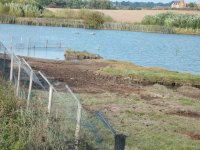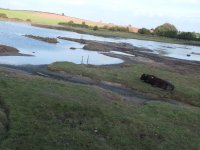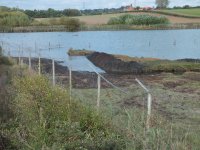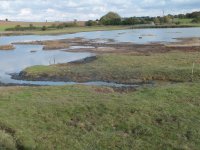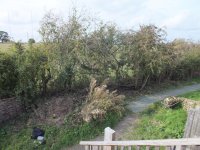Another first light start at the FLASHES, with rain starting just as I arrived and not stopping until 11am. Throughout the morning a few meadow pipits moved through and some landing in front of the hide. A lone swallow fed over the 1st Flash during heavy rain. But these were the only VIS MIGrants I saw.
All the overnight roosters were hunkered down, with a good number of BHG's.
Only 3 of us (Rob G Matt fuzeare) on site by the time I moved to the Moors, where Gaseous Clay and his MRs were the only people there.
Here things were almost as yesterday , with a slight increase in wigeon. But most passerines, apart from singing Cettis were none existent. The only other passerine of note was a high flying small thrush circling and reluctant to land, which could have been a redwing.
species counts
FLASHES: Little egret, Teal 120, shoveler 49, mallard 150, mute swan, greylag 3, canadas 250 roosted, green sand, snipe 7, curlew 20, lapwing 15, BHG 1600, Herring gull 4, LBBG 7,several 100's of large gulls moved south shortly after first light. coot 10, water rail 2 calling, sparrowhawk, cettis singing, chiffchaff 2, lots of passerines sheltering in bushes right of sewage works - blackbird 12, song thrush 3, starling 10, chaffinch 2, reed bunting 4, plus goldfinches, tits and robins. It is certainly worth scoping this area as passerines regularly gather there. Grey wag 2, pied wag 5,
VIS MIG -meadow pipit 30, swallow,
MOORS: GCG 5, Little grebe 8+, little egret 3, wigeon 13, shoveler c20, teal 30, greylag c15, common sand, snipe 10, lapwing 150, cettis 3 singing. grey wag 2,
A38 FIELD, behind concrete hide. As I was driving out of the reserve I noticed a large flock of birds get up from this field. It has just been rolled and whether as a result of the rain or not it held a good mixed flock including: lapwing 150, BHG 250, stock dove 10, starling 220, pied wags 45 - 50. Unfortunately I couldn't give it more than 5 minutes before I had to leave. So if you are on the reserve tomorrow check it out. B
Can I add to that the hide overlooking the new sluice gate shows great potential with lots of passerines and 2 snipe arriving just as I left. A kingfisher used the new gate as a perch showing for a good few minutes before flying off towards the sailing lake. Well worth having a look.





